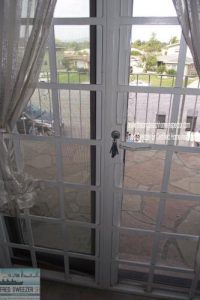Safety is more important than Security Window Bars
Window bars (also called safety bars and security bars) are metal bars that are installed to prevent intruders from entering a building. As an unintended consequence, window bars can slow or prevent egress during an emergency.
Facts
Roughly 25 people die or are injured annually in fires where escape is hindered by window bars.
According to the National Fire Protection Agency, the number of deaths caused by fire related to security bars is on the rise. The fear of burglary, theft and/or physical attack presents a greater perceived risk than the threat of fire. Seventy people died in a hotel fire on August 18, 2001 in the Philippines. The victims were trapped inside the six-story hotel by window bars.
Advantages of Window Bars
They are a deterrent to potential burglars. They are mostly used in ground-floor windows, which are most vulnerable to intrusion. They provide a sense of security to building occupants.
They can prevent children from falling out of the window. Disadvantages of Window Bars
They can block the exit for occupants during an emergency, such as a fire. The occupants may feel secure from burglary, but they have severely limited their avenues of egress. Ironically, it is possible for occupants to become trapped behind window bars while trying to escape from an intruder who has managed to enter the building. They can potentially block the entry point for firefighters. Houses equipped with window bars can potentially decrease the home’s property value. Window bars can make a neighborhood appear insecure to potential home buyers.
Requirements for a Quick-Release Mechanism

Safety Issue
According to the 2006 International Residential Code (IRC), basements and sleeping rooms should have at least one operable emergency escape and rescue opening. Windows that are equipped with bars and which are intended for emergency egress should have a quick-release mechanism installed. If a room’s egress requirements are already satisfied by another window or door, it is still helpful for window bars to be equipped with a quick-release mechanism. Where window bars are installed in windows that are part of a building’s means of egress, the IRC requires that they be equipped with a quick-release mechanism that complies with the following requirements:
It should be accessible from the inside of the house. Although not addressed by the IRC, the device should not be accessible from outside the house if the window were to be broken.
It should not require a key or combination. Likely reasons for this requirement are as follows:
During an emergency, occupants may become too panicked or confused to remember the combination or where they put the key.
single cylinder lock
Fire and smoke may prevent access to the key or obscure view of the lock. Occupants may not know the combination or know where the key was placed. It should not require any special tools, such as a screwdriver. The mechanism should be able to be operated with relatively little force. Children and the elderly should be strong enough to operate the release mechanism.
Operation of the mechanism should not require special knowledge. Although beyond the scope of InterNACHI’s Standards of Practice, inspectors may want to test release mechanisms to make sure that they comply with the IRC’s requirements. Even if the mechanism appears functional, it is possible that its ability to operate has become compromised by rust, paint, or some other factor. Inspectors should call out any hindrances to the release mechanism’s functionality as a safety defect.
In summary, window bars are valuable anti-burglary features in residences, but they should be able to be easily disengaged so occupants are not trapped during an emergency.
Fred Sweezer Sr
Certified Home Inspector
HUD Certified 203K Consultant S0712
FHA Compliance Inspector T477